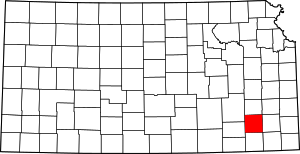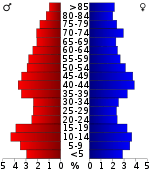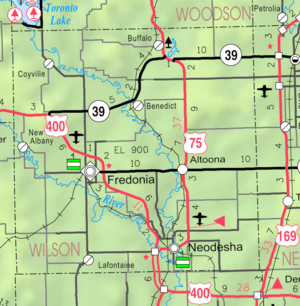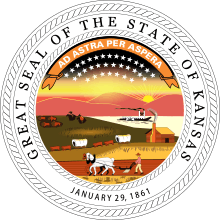Wilson County, Kansas
Wilson County (standard abbreviation: WL) is a county located in the U.S. state of Kansas. As of the 2010 census, the county population was 9,409.[1] Its county seat is Fredonia.[2]
Wilson County | |
|---|---|
 Brown Hotel in Neodesha (2017) | |
 Location within the U.S. state of Kansas | |
 Kansas's location within the U.S. | |
| Coordinates: 37°34′00″N 95°44′00″W | |
| Country | |
| State | |
| Founded | 1855 |
| Named for | Hiero T. Wilson |
| Seat | Fredonia |
| Largest city | Neodesha |
| Area | |
| • Total | 575 sq mi (1,490 km2) |
| • Land | 570 sq mi (1,500 km2) |
| • Water | 4.7 sq mi (12 km2) 0.8% |
| Population (2010) | |
| • Total | 9,409 |
| • Estimate (2018) | 8,665 |
| • Density | 16/sq mi (6.3/km2) |
| Time zone | UTC−6 (Central) |
| • Summer (DST) | UTC−5 (CDT) |
| Congressional district | 2nd |
| Website | wilsoncountykansas.org |
History
Early history
For many millennia, the Great Plains of North America was inhabited by nomadic Native Americans. From the 16th century to 18th century, the Kingdom of France claimed ownership of large parts of North America. In 1762, after the French and Indian War, France secretly ceded New France to Spain, per the Treaty of Fontainebleau.
19th century
In 1802, Spain returned most of the land to France, but keeping title to about 7,500 square miles. In 1803, most of the land for modern day Kansas was acquired by the United States from France as part of the 828,000 square mile Louisiana Purchase for 2.83 cents per acre.
In 1854, the Kansas Territory was organized. In 1855, Wilson County was established and included what is now Wilson County and Montgomery County. It was named for Colonel Hiero T. Wilson. He was a successful Indian trader who had been the first white settler of Fort Scott, Kansas and had served as postmaster and sutler at the fort. He could speak Cherokee, Creek, and Osage and the Osage called him "Big White Chief". He was a delegate to the Lecompton Constitutional Convention. [3]
Geography
According to the U.S. Census Bureau, the county has a total area of 575 square miles (1,490 km2), of which 570 square miles (1,500 km2) is land and 4.7 square miles (12 km2) (0.8%) is water.[4]
Adjacent counties
- Woodson County (north)
- Allen County (northeast)
- Neosho County (east)
- Montgomery County (south)
- Elk County (west)
- Greenwood County (northwest)
Demographics
| Historical population | |||
|---|---|---|---|
| Census | Pop. | %± | |
| 1860 | 27 | — | |
| 1870 | 6,694 | 24,692.6% | |
| 1880 | 13,775 | 105.8% | |
| 1890 | 15,286 | 11.0% | |
| 1900 | 15,621 | 2.2% | |
| 1910 | 19,810 | 26.8% | |
| 1920 | 21,157 | 6.8% | |
| 1930 | 18,646 | −11.9% | |
| 1940 | 17,723 | −5.0% | |
| 1950 | 14,815 | −16.4% | |
| 1960 | 13,077 | −11.7% | |
| 1970 | 11,317 | −13.5% | |
| 1980 | 12,128 | 7.2% | |
| 1990 | 10,289 | −15.2% | |
| 2000 | 10,332 | 0.4% | |
| 2010 | 9,409 | −8.9% | |
| Est. 2018 | 8,665 | [5] | −7.9% |
| U.S. Decennial Census[6] 1790-1960[7] 1900-1990[8] 1990-2000[9] 2010-2016[1] | |||

As of the census[10] of 2000, there were 10,332 people, 4,203 households, and 2,849 families residing in the county. The population density was 18 people per square mile (7/km²). There were 4,937 housing units at an average density of 9 per square mile (3/km²). The racial makeup of the county was 96.78% White, 0.37% Black or African American, 0.88% Native American, 0.26% Asian, 0.04% Pacific Islander, 0.48% from other races, and 1.19% from two or more races. 1.67% of the population were Hispanic or Latino of any race.
There were 4,203 households out of which 29.60% had children under the age of 18 living with them, 57.10% were married couples living together, 7.80% had a female householder with no husband present, and 32.20% were non-families. 29.10% of all households were made up of individuals and 15.80% had someone living alone who was 65 years of age or older. The average household size was 2.40 and the average family size was 2.96.
In the county, the population was spread out with 25.40% under the age of 18, 7.40% from 18 to 24, 23.80% from 25 to 44, 23.40% from 45 to 64, and 19.90% who were 65 years of age or older. The median age was 41 years. For every 100 females there were 94.20 males. For every 100 females age 18 and over, there were 89.60 males.
The median income for a household in the county was $29,747, and the median income for a family was $36,990. Males had a median income of $27,255 versus $18,670 for females. The per capita income for the county was $14,910. About 7.50% of families and 11.30% of the population were below the poverty line, including 13.40% of those under age 18 and 11.80% of those age 65 or over.
Government
Presidential elections
| Year | Republican | Democratic | Third Parties |
|---|---|---|---|
| 2016 | 77.6% 2,788 | 16.5% 594 | 5.8% 209 |
| 2012 | 76.0% 2,825 | 22.0% 818 | 2.0% 74 |
| 2008 | 69.2% 2,850 | 28.4% 1,170 | 2.5% 101 |
| 2004 | 74.2% 3,263 | 24.1% 1,060 | 1.7% 75 |
| 2000 | 67.1% 2,748 | 29.0% 1,186 | 3.9% 161 |
| 1996 | 56.4% 2,458 | 29.8% 1,297 | 13.8% 602 |
| 1992 | 41.5% 1,925 | 28.7% 1,331 | 29.8% 1,379 |
| 1988 | 63.1% 2,743 | 35.6% 1,545 | 1.3% 58 |
| 1984 | 72.2% 3,663 | 26.5% 1,344 | 1.3% 64 |
| 1980 | 69.3% 3,328 | 25.1% 1,205 | 5.6% 268 |
| 1976 | 55.7% 2,682 | 42.5% 2,047 | 1.9% 89 |
| 1972 | 74.8% 3,568 | 21.9% 1,043 | 3.3% 159 |
| 1968 | 63.4% 3,340 | 24.2% 1,276 | 12.4% 656 |
| 1964 | 52.5% 2,919 | 46.7% 2,592 | 0.8% 45 |
| 1960 | 67.8% 4,333 | 31.8% 2,034 | 0.4% 27 |
| 1956 | 73.0% 4,502 | 26.7% 1,645 | 0.3% 20 |
| 1952 | 73.2% 5,180 | 26.1% 1,845 | 0.8% 53 |
| 1948 | 59.5% 3,868 | 39.0% 2,538 | 1.5% 100 |
| 1944 | 68.6% 4,248 | 30.9% 1,912 | 0.6% 35 |
| 1940 | 64.4% 5,288 | 34.8% 2,859 | 0.8% 62 |
| 1936 | 55.6% 4,829 | 43.9% 3,816 | 0.5% 42 |
| 1932 | 44.9% 3,422 | 52.5% 4,001 | 2.5% 193 |
| 1928 | 78.5% 5,603 | 20.5% 1,465 | 1.0% 73 |
| 1924 | 65.0% 4,596 | 24.6% 1,736 | 10.5% 739 |
| 1920 | 66.2% 4,024 | 29.1% 1,768 | 4.7% 284 |
| 1916 | 41.8% 2,970 | 49.2% 3,494 | 9.0% 640 |
| 1912 | 19.9% 849 | 30.6% 1,304 | 49.5% 2,108[lower-alpha 1] |
| 1908 | 53.1% 2,428 | 38.9% 1,777 | 8.0% 364 |
| 1904 | 63.4% 2,583 | 25.4% 1,034 | 11.3% 459 |
| 1900 | 55.6% 2,193 | 43.4% 1,711 | 1.1% 42 |
| 1896 | 48.4% 1,852 | 51.2% 1,959 | 0.4% 17 |
| 1892 | 51.8% 1,803 | 48.2% 1,678 | |
| 1888 | 55.5% 2,191 | 26.2% 1,035 | 18.3% 723 |
Wilson County is overwhelmingly Republican. No Democratic Presidential candidate has carried Wilson County since Franklin D. Roosevelt in 1932, and none have passed 36 percent since Jimmy Carter in 1976.
Education
Unified school districts
Communities

Unincorporated communities
Townships
Wilson County is divided into fifteen townships. The cities of Fredonia and Neodesha are considered governmentally independent and are excluded from the census figures for the townships. In the following table, the population center is the largest city (or cities) included in that township's population total, if it is of a significant size.
| Township | FIPS | Population center |
Population | Population density /km² (/sq mi) |
Land area km² (sq mi) | Water area km² (sq mi) | Water % | Geographic coordinates |
|---|---|---|---|---|---|---|---|---|
| Cedar | 11375 | 701 | 8 (19) | 93 (36) | 0 (0) | 0.11% | 37°31′21″N 95°40′14″W | |
| Center | 12225 | 618 | 6 (16) | 103 (40) | 0 (0) | 0.14% | 37°31′5″N 95°49′11″W | |
| Chetopa | 13000 | 188 | 2 (5) | 93 (36) | 0 (0) | 0.11% | 37°30′28″N 95°34′14″W | |
| Clifton | 14250 | 414 | 4 (12) | 93 (36) | 0 (0) | 0.53% | 37°41′56″N 95°42′23″W | |
| Colfax | 14825 | 452 | 4 (10) | 123 (47) | 0 (0) | 0.17% | 37°40′55″N 95°36′20″W | |
| Duck Creek | 18800 | 103 | 1 (3) | 93 (36) | 0 (0) | 0.23% | 37°26′14″N 95°54′58″W | |
| Fall River | 22825 | 398 | 3 (8) | 131 (51) | 0 (0) | 0.16% | 37°32′21″N 95°55′33″W | |
| Guilford | 29200 | 205 | 2 (6) | 93 (36) | 0 (0) | 0.06% | 37°36′32″N 95°43′22″W | |
| Neodesha | 49675 | 583 | 6 (17) | 90 (35) | 0 (0) | 0.52% | 37°25′29″N 95°40′52″W | |
| Newark | 50200 | 226 | 2 (6) | 92 (36) | 0 (0) | 0.18% | 37°25′30″N 95°34′56″W | |
| Pleasant Valley | 56650 | 201 | 2 (4) | 123 (47) | 0 (0) | 0.09% | 37°36′25″N 95°36′21″W | |
| Prairie | 57425 | 118 | 2 (4) | 78 (30) | 0 (0) | 0.28% | 37°36′17″N 95°49′26″W | |
| Talleyrand | 69900 | 232 | 3 (7) | 92 (36) | 0 (0) | 0.06% | 37°25′19″N 95°48′25″W | |
| Verdigris | 73500 | 394 | 4 (10) | 103 (40) | 0 (0) | 0.27% | 37°39′29″N 95°53′51″W | |
| Webster | 76300 | 51 | 1 (2) | 77 (30) | 0 (0) | 0.15% | 37°42′0″N 95°50′1″W |
See also
|
|
Notes
- This comprises 1,415 votes (33.21 percent) for Progressive Theodore Roosevelt (who carried the county), and 693 votes (16.26 percent) for Socialist Eugene V. Debs.
Citations
- "State & County QuickFacts". United States Census Bureau. Retrieved July 29, 2014.
- "Find a County". National Association of Counties. Retrieved 2011-06-07.
- Rydjord, p 317
- "US Gazetteer files: 2010, 2000, and 1990". United States Census Bureau. 2011-02-12. Retrieved 2011-04-23.
- "Population and Housing Unit Estimates". Retrieved November 29, 2019.
- "U.S. Decennial Census". United States Census Bureau. Retrieved July 29, 2014.
- "Historical Census Browser". University of Virginia Library. Retrieved July 29, 2014.
- "Population of Counties by Decennial Census: 1900 to 1990". United States Census Bureau. Retrieved July 29, 2014.
- "Census 2000 PHC-T-4. Ranking Tables for Counties: 1990 and 2000" (PDF). United States Census Bureau. Retrieved July 29, 2014.
- "U.S. Census website". United States Census Bureau. Retrieved 2008-01-31.
- http://uselectionatlas.org/RESULTS
- "Map of Wet and Dry Counties". Alcoholic Beverage Control, Kansas Department of Revenue. November 2006. Archived from the original on 2007-10-08. Retrieved 2007-12-26.
- Rydjord, John (1972). Kansas Place-Names. University of Oklahoma Press, Norman, Oklahoma. p. 474. ISBN 0-8061-0994-7.
- Rydjord, John (1972). Kansas Place-Names. University of Oklahoma Press, Norman, Oklahoma. p. 88. ISBN 0-8061-0994-7.
References
- Rydjord, John (1972). Kansas Place-Names. University of Oklahoma Press, Norman, Oklahoma. ISBN 0-8061-0994-7.
Further reading
- Handbook of Wilson County, Kansas; C.S. Burch Publishing Co; 44 pages; 1886.
- Standard Atlas of Wilson County, Kansas; Geo. A. Ogle & Co; 52 pages; 1910.
- Historical Atlas of Wilson County, Kansas; John P. Edwards; 35 pages; 1881.
